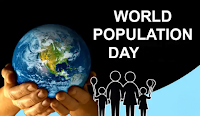World Population day
Date:- July 11Frequency:- annual

World Population day is an annual event, observed on July 11 every year, which seeks to raise awareness of global population issues. The event was established by the Governing Council of the United Nations Development Programme in 1989.
World Population Day, which seeks to focus attention on the urgency and importance of population issues, was established by the then-Governing Council of the United Nations Development Programme in 1989, an outgrowth of the interest generated by the Day of Five Billion, which was observed on 11 July 1987.
At the time of the first World Population Day, about 5.25 billion people trod the Earth. Now, about 7.7 billion of us share the globe, and the number is expected to increase to 8.5 billion by 2030. By 2100, it is projected that the population will be above 11 billion, more than double the population on the first World Population Day 30 years ago.
This year's World Population Day calls for global attention to the unfinished business of the 1994 International Conference on Population and Development. Twenty-five years have passed since that landmark conference, where 179 governments recognized that reproductive health and gender equality are essential for achieving sustainable development.
To identify the countries with the fastest growing populations, 24/7 Tempo reviewed the 2018 World Population Data Sheet produced by the Population Reference Bureau (PRB).
Today’s largest countries in population – China, India, and the United States – are expected to remain among the most populous, though their growth rates are not among the fastest. According to data recently released by the population data-gathering organization Population Reference Bureau, that distinction belongs to 20 countries in Africa and Asia, where populations have surged in recent years. The rapid population growth is expected to continue into 2050, fueled by increased life expectancy and declining mortality and high fertility rates associated with a largely youthful – and booming – population.

No comments:
Post a Comment